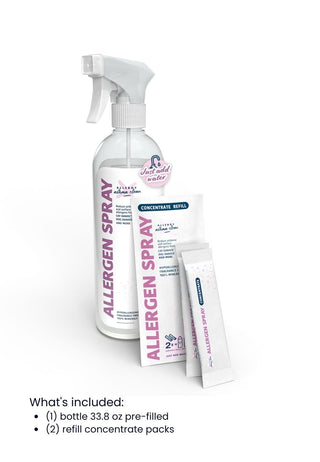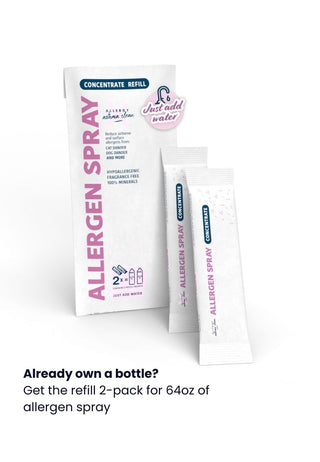

The Complete
Allergy Relief Starter Guide
The Multicomponent Approach
Grappling with allergies
From creating allergen-free sleep havens to incorporating nutritional supplements, air purifiers, and more, this guide seeks to empower allergy sufferers with a curated toolkit for a life less interrupted by allergic reactions.

Definition of Allergies
Allergies, a common immune system response, occur when the body reacts to substances perceived as harmful, known as allergens. These allergens can vary widely and may include pollen, dust mites, pet dander, mold spores, and certain foods. The immune system, in its attempt to defend the body, releases chemicals like histamines, leading to allergic symptoms such as sneezing, itching, congestion, and more. Understanding the basics of allergic reactions sets the foundation for effective allergy management.
Identifying Personal Triggers
Each individual's allergic profile is unique, making it crucial to identify personal triggers. A comprehensive approach to allergy relief begins with recognizing specific allergens that prompt reactions. Allergy testing, whether through skin tests or blood tests, can pinpoint these triggers, providing valuable insights into the substances that provoke allergic responses. By understanding personal triggers, individuals can tailor their approach to effectively mitigate exposure and reduce the frequency and severity of allergic reactions. This knowledge is the first step toward a targeted and personalized allergy relief strategy.
Common Triggers
Pet lovers may find themselves contending with cat and dog dander, minute particles shed by these furry companions that can trigger sneezing, itching, and respiratory discomfort. In the realm of indoor allergens, dust mites, cockroach droppings, and exposure to mice can pose challenges, especially in homes where thorough cleanliness may be challenging. Mold spores, ubiquitous in damp environments, carry their own set of allergenic properties. Outdoor allergens, including pollen from trees, grasses, and weeds, can exacerbate symptoms during different seasons. Even the presence of birds, with their feathers and droppings, may contribute to allergic responses.
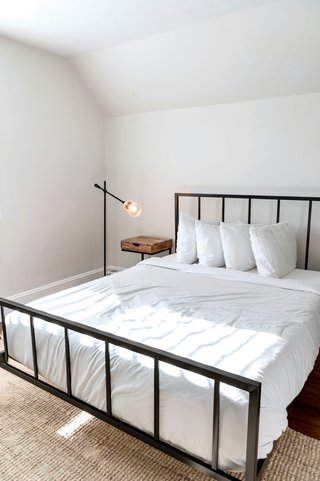
Mattress covers and bedding options
Allergen-proof bedding stands as a sophisticated solution in the quest for a sleep environment free from common allergens. The effectiveness of these bedding products lies in their advanced construction and materials, offering a multi-layered defense against dust mites and more.
Types of mattress covers and bedding
Materials and types
- Material Selection: High-quality mattress covers are typically crafted from tightly woven fabrics with microscopic pores. These pores are small enough to prevent allergens from passing through, effectively sealing the mattress.
- Impermeable Seal: The key to their effectiveness lies in their impermeability. Premium brands utilize advanced technologies to create covers with sealed seams and durable zippers, ensuring a complete enclosure around the mattress. This impermeable seal not only prevents allergens from entering but also traps any existing allergens within the mattress, keeping them away from the sleeper.
- Zippered Encasements: Allergen-proof pillows, duvets, and mattress toppers often feature zippered encasements. This design ensures complete coverage, encasing the bedding from all sides and sealing it off from potential allergen intrusion. The secure closure not only prevents allergens from entering but also traps any existing particles within the encasement.
- Breathable Fabrics: Despite their impermeability to allergens, allergen-proof bedding is engineered to be breathable. This ensures that air circulation remains optimal, providing comfort without compromising on the protective barrier. This feature is particularly crucial for maintaining a comfortable sleep temperature.
- Waterproofing: Some covers go a step further by incorporating waterproof layers. This not only protects against allergens but also guards against liquid spills and stains, enhancing the longevity of the mattress.
Types and brands
Allergen-Proof Pillow Covers:
- Brands: Mission: Allergy, National Allergy, AllerEase
- Features: These covers encase pillows with tightly woven fabric, preventing allergens from penetrating. Zippered closures ensure complete protection, and hypoallergenic treatments add an extra layer of defense.
Allergen-Proof Duvet Covers:
- Brands: Mission: Allergy, SureGuard
- Features: Duvet covers with allergen-proof encasements, featuring zipper closures and microscopic pore structures. Waterproof options add an extra layer of protection against spills.
Allergen-Proof Mattress Encasements:
- Brands: SafeRest, SureGuard, AllerEase
- Features: These encasements cover the entire mattress, sealing it against allergens. High-quality options are waterproof, bed bug-resistant, and feature breathable fabrics for comfort.
Allergen-Proof Mattress Toppers
- Brands: AllerEase, National Allergy
- Features: Mattress toppers with allergen-proof properties add an extra layer of protection to the mattress surface. These can be an effective solution for enhancing the allergen resistance of the sleep environment.
Allergen-Proof Blanket Covers
- Brands: SureGuard, National Allergy
- Features: Blanket covers designed to encase blankets with allergen-proof features. Zippered closures and hypoallergenic treatments contribute to their effectiveness.
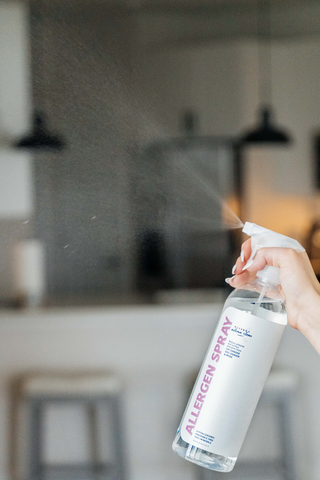
Allergen Spray
Allergen Spray is an alternative solution to reduce airborne and surface allergens. This spray works by surrounding, dropping, and dehydrating the allergens rendering them inactive, all without harsh chemicals. Backed by world-leading science, Allergen Spray is designed to be integrated into your everyday routine for a healthier and happier life indoors.
A New Approach to Allergy Care
Effective at Reducing Allergens: Lab-verified Allergen Spray reduces allergens in the air and on surfaces, making it a good option for those with allergies and allergic asthma.
Affordable: Allergen Spray is low-cost and readily available, making it an accessible option for many.
No pills or medication: Allergen Sprays don't require taking any medications, so you don't have to worry about side effects.
Full control: Allergen Spray is the only product on the market that can reduce both airborne and surface allergens; achieving air and surface control is essential to manage indoor allergens effectively.

Role of Supplements in Allergy Relief
Nutritional supplements offer a targeted approach to allergy support by providing essential nutrients that modulate immune responses and reduce inflammation. Certain supplements have demonstrated efficacy in alleviating allergic symptoms and promoting overall immune health. Integrating these supplements into a well-balanced diet can enhance the body's resilience against allergens.
Supplements
Quercetin: A flavonoid with potent antioxidant properties, quercetin has anti-inflammatory effects and may help stabilize cells that release histamine.
Vitamin C: Known for its immune-boosting properties, vitamin C acts as a natural antihistamine.
Omega-3 Fatty Acids: Found in fish oil, flaxseed oil, and walnuts, omega-3 fatty acids have anti-inflammatory effects.
D-Hist: is a natural dietary supplement that is designed to support respiratory health and help relieve allergy symptoms. It contains a blend of flavonoids, antioxidants, and other natural compounds that work together to reduce inflammation and improve immune function.
Stinging Nettle: Stinging nettle is another herb that has been used for centuries to treat allergies. It works by reducing inflammation in the body and blocking the production of histamines. "In another study, 57% of patients rated nettles as effective in relieving allergies, and 48% said that nettles were more effective than allergy medications they had used previously.
Butterbur: Is a natural supplement that has been traditionally used to manage allergies, particularly hay fever. It contains compounds called petasins, which have been shown to have anti-inflammatory and antihistamine effects. Butterbur works by inhibiting the release of histamines and leukotrienes, which are chemicals released by the body in response to allergens and cause allergy symptoms like sneezing, runny nose, and itchy eyes.
Probiotics: Beneficial bacteria in the gut play a crucial role in immune function. Probiotic supplements support a healthy gut microbiome, enhancing immune responses.
It could be advisable to undergo a blood test to identify any nutritional deficiencies before incorporating supplements into your routine. Always consult with your doctor before initiating or discontinuing any medications or supplements to ensure they align with your individual health needs and conditions.
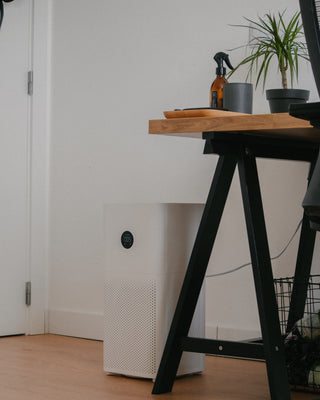
Air Purifiers
Air purifiers stand as one of the ways to get allergy relief by mitigating airborne allergens and enhancing indoor air quality.
How Air Purifiers Work
Air purifiers operate on the principle of filtration, removing particles from the air to improve its quality. The core components of air purifiers include:
HEPA Filters: High-Efficiency Particulate Air (HEPA) filters capture particles as small as 0.3 microns, effectively trapping allergens like dust mites, pollen, pet dander, and mold spores.
Activated Carbon Filters: These filters excel in trapping odors, gases, and volatile organic compounds (VOCs), contributing to a fresher and cleaner indoor environment.
UV-C Light Technology: Some air purifiers incorporate UV-C light to neutralize bacteria, viruses, and mold spores, adding an extra layer of microbial protection.
Clean Air Delivery Rate (CADR) is a metric used to measure the effectiveness of air purifiers in removing specific airborne particles from the indoor air. CADR is expressed as a numerical value and is typically provided by the manufacturer to help consumers assess the purifier's performance. Each CADR value is given in cubic feet per minute (CFM) and represents the volume of clean air that the purifier can deliver. Higher CADR values generally indicate a more effective air purifier for that particular type of particle.
Choosing the Right Air Purifier
Selecting an air purifier tailored to specific needs is crucial for optimal allergy relief. Consider the following factors:
Room Size: Choose an air purifier with a Clean Air Delivery Rate (CADR) suitable for the size of the room. This ensures efficient and effective air purification.
Filtration System: HEPA filters are highly effective for allergen removal, but certain purifiers may feature additional filtration layers for specialized needs.
Noise Level: Evaluate the noise level of the air purifier, especially if it will be used in bedrooms or other quiet spaces.
Maintenance and Filter Replacement: Check the ease of maintenance and the cost and frequency of filter replacements. Regular filter changes are essential for optimal performance.
Noteworthy Air Purifier Brands
Several reputable brands offer high-quality air purifiers designed for allergy relief:
Dyson: Known for their advanced technology and design, Dyson air purifiers often incorporate HEPA and activated carbon filters.
Honeywell: Honeywell offers a range of air purifiers with HEPA filters, suitable for various room sizes.
Blueair: Renowned for their high-performance air purifiers, Blueair models often feature combination filters for comprehensive allergen removal.
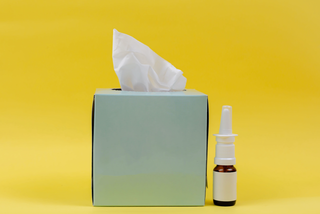
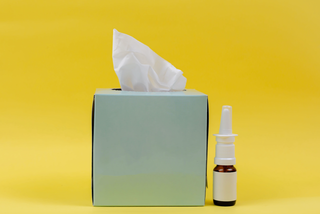
Nasal Irrigation and Allergy-Friendly Products
Nasal irrigation and the use of allergy-friendly products constitute valuable components in the arsenal against allergic reactions. This section explores the benefits of nasal irrigation and introduces a range of products designed to provide relief from allergies while promoting overall nasal health.
Benefits of Nasal Irrigation:
Nasal irrigation, often performed with a saline solution, is a time-tested method for clearing nasal passages and alleviating allergy symptoms. The benefits include:
Removal of Allergens: Nasal irrigation flushes out allergens such as pollen, dust, and irritants, reducing their presence in the nasal passages.
Mucus Reduction: It helps thin mucus and clear nasal congestion, making it easier to breathe and reducing the likelihood of sinus-related discomfort.
Hydration: Nasal irrigation maintains nasal moisture, preventing dryness and irritation associated with allergies.
Allergy-Friendly Products:
Neti Pots: These devices facilitate nasal irrigation by allowing the controlled flow of saline solution through nasal passages, promoting effective cleansing.
Saline Nasal Sprays: Convenient for on-the-go use, saline nasal sprays provide a quick and easy way to hydrate nasal passages and flush out allergens.
Allergy-Friendly Tissues: Hypoallergenic tissues are designed to be gentle on the skin and reduce the risk of irritation during frequent nose blowing.
Nasal Filters: These discreet filters, worn inside the nostrils, act as barriers against airborne allergens, providing an extra layer of protection in allergy-prone environments.
HEPA Vacuum Filters: HEPA (High-Efficiency Particulate Air) vacuum filters are indispensable components in the pursuit of a clean and allergen-free living space. These filters are specifically designed to capture microscopic particles, including dust mites, pet dander, pollen, and mold spores, that conventional vacuum filters might miss. The effectiveness of HEPA vacuum filters lies in their ability to trap particles as small as 0.3 microns with a high level of efficiency. By incorporating HEPA filters into vacuum cleaners, individuals can significantly reduce the presence of allergens in carpets, upholstery, and other surfaces, creating an environment that is not only visibly cleaner but also healthier for allergy sufferers.



